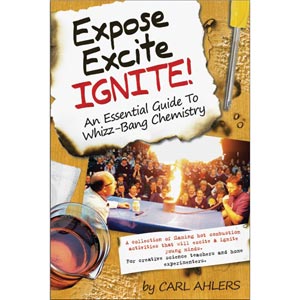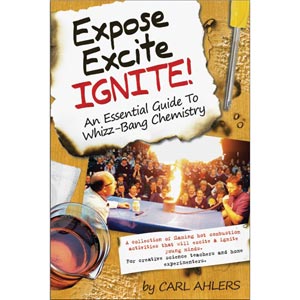Next time you step onto the beach, bend down, grab a handful of sand and admire the fact: By mass 47% of what you hold in your hand is the element silicon. The rest is simply oxygen. Remarkable!
Silicon is the second most abundant element in the earth’s crust (27.7%) – only oxygen beats it – and can easily be extracted from white sand (SiO2) in a spectacular reaction in the school science laboratory.
Thermite Reactions
In Thermite reactions metal oxides react with aluminum to produce the molten metal. These redox reactions require substantial activation energy to get going and are highly exothermic.
They have been used industrially for welding (even under water), the preparation of metals from their oxides (reduction) and the production of incendiary devices. The process is initiated by heat but then becomes self-sustaining.
In the early 1900’s a product called Thermit® was developed and used worldwide to weld rail tracks. The photo (taken by J J Szerkeszto) was taken in 2010 proving that it is still in use today. This is the reaction:
Fe2O3 + 2Al → 2Fe + Al2O3 + energy
The question is: Can silicon be persuaded to give up its oxygen in a similar thermite process?
For Fe2O3 , ∆Hf = -822 kJ/mole; for SiO2 , ∆Hf = – 859 kJ/mole
In 1902, Kuhn described a method that is a variation of the thermite reaction for the reduction of silicon from silicon oxide. In this process a primary reaction provides the activation energy to initiate the secondary reduction reaction.
Extracting Silicon from Sand
Safety / Risk Assessment
★ Burning magnesium produces bright light that may cause temporary loss of sight. Avoid looking directly at the flare.
★ Magnesium is very reactive and contact with other chemicals may result in explosion.
★ This demonstration produces intense heat and molten silicon. A dry-powder fire extinguisher should be readily available at all times. DO NOT use water as an extinguisher as this will produce potentially explosive hydrogen gas.
★ The near-impossibility of smothering and the high temperatures generated make thermite reactions potentially hazardous. Appropriate precautions must be taken before thermite is ignited. Keep all flammable material away from the area.
★ The reaction should be performed in a fume cupboard or outdoors behind a safety shield as it produces intense heat, smoke and molten metal. Sparks can fly up to 2 m horizontally.
★ Wear heat-protective welding gloves and use metal tongs to handle the fragments of the clay pot and molten silicon after the reaction has taken place.
★ Wear protective clothing and safety glasses.
Chemical Safety
Aluminum (Al)
Risk phrases: R10 – 15 Extremely flammable; Contact with water liberates highly flammable gases.
Safety phrase: S7/8/44 Keep container tightly closed; Keep container dry.
Magnesium (Mg)
Risk phrases: R11-15 Extremely flammable; Contact with water liberates highly flammable gases.
Safety phrase: S7/8-43 Keep container tightly closed; Keep container dry.
Hydrochloric Acid (HCl) is a strong acid. Treat with the greatest respect.
Risk phrases: R34-37 Causes severe burns; Irritating to eyes & respiratory system.
Safety phrase: S2-26 Keep out of reach of children; In case of contact with eyes, rinse immediately with plenty of water and seek medical advice; Wear suitable gloves and eye/face protection.
Sodium hydroxide (NaOH) destroys clothes and causes injury to the skin. Treat with the greatest respect.
Risk phrases: R35 Causes severe burns
Safety phrase: S2/26/37/39 Keep out of reach of children; In case of contact with eyes, rinse immediately with plenty of water and seek medical advice; Wear suitable gloves and eye/face protection.
What You Will Need
Chemicals
• Aluminum powder, 325 mesh or finer
• Powdered sulfur
• Dry white sand – beach sand or washed white builder’s sand
• Hydrochloric acid, 4M (add 180 mL conc. HCl to 500 mL water)
Initiator chemicals:
• Fine magnesium powder & magnesium ribbon (5 cm) or Potassium permanganate (KMnO4) and glycerine
Other
• Mortar & pestle
• Small clay flower pot, ∼ 6.5 cm (2.5”) inside top diameter
• Small glass beaker & plastic container
• Electronic balance, 100 g ± 0.1 g
• Heat resistant pad
• Transparent safety shield or fume cupboard
• Heat-protective gloves eg. welding gloves
• Spatula & metal tongs
• Fire lighter with long stem
Here’s How
1. Dry about 50 g of sand in an oven for 2 hours (∼ 350℉) and then grind the sand to a powdered form in a mortar and pestle.
2. Weigh and mix the following to form a homogenous mix:
8 g of dry aluminum powder
10 g of powdered sulfur
7 g of dry powdered sand
3. The best mix is obtained by shaking the mixture for a minute in a sealed plastic container. Do NOT grind them together in a mortar and pestle.
4. Use the small clay flower pot. If it has a hole in the bottom – cover the hole with paper. Transfer all of the mix to the pot.
5. Make a small cone-shaped indentation at the top (¾” deep and ¾” wide) and fill this with magnesium powder to facilitate ignition. (For an alternative method see Note 1 in the book). Fray a 5 cm (2”) magnesium ribbon’s end with scissors. This will enlarge its surface area and aid ignition. Push this fuse into the magnesium powder pile.
Safety: Position the pot on a heat resistant pad in a fume cupboard or outdoors away from any combustible material. Use a safety shield. Wear protective eye wear, gloves and a lab coat.
Light the frayed end of the magnesium ribbon using a long stemmed fire lighter. It may take a few seconds before the ribbon starts burning. Once this happens – step back immediately. Ignition of the mixture is not instantaneous and might take as long as 60 seconds. The reaction will produce lots of spattering, bright light and intense heat. The temperature is reported to be well above 2,200℃ (4,000℉). The residue will have an orange-red glow and be hot for some time. If required, carefully pick up the red-hot residue using metal tongs.
NOTE:
If the reaction fails to react: Wait 3 minutes. Do not approach the reaction vessel until you are sure ignition is not possible. Replace the ribbon or add more magnesium powder. Try again.
7. Purify the silicon residue.
Leave the clay pot to cool for 20 minutes. Break the pot apart and separate the silicon residue from the clay pieces. Break the residue into smaller pieces using light taps from a hammer.
8. The silicon (Si) and aluminum oxide (Al2O3) is now separated from the aluminum sulphide (Al2S3) by adding the residue to diluted hydrochloric acid in a glass beaker (acid – take care!). Copious amounts of hydrogen sulphide will be evolved – foul smelling rotten egg gas – use a fume cupboard or perform outside.
Al2S3 + 6HCl → 2AlCl3 + 3H2S
Leave the residue in the acid until gas formation subsides. This process may take up to 20 minutes. The finer the residue, the faster this reaction.
9. Now, carefully discard the acid under running water and wash the residue in the beaker for 30 seconds. The silicon will be found in the form of pea-size, hard, black, crystalline globules. It is insoluble in most acids. Boil the globules in a glass beaker using dilute hydrochloric acid for further purification.
Disposal
Allow the solids and clay fragments to cool to room temperature. The clay flower pot invariably cracks and should not be re-used. Dispose of all solids in the waste bin.
The Chemistry
There are basically three reactions here that produce a chain reaction effect. Magnesium burns in oxygen and produces the activation energy to get the sulfur and aluminum going.
2Mg + O2 → 2MgO + energy
The aluminum and sulfur again, react in an exothermic reaction that is the source of activation energy for the silica and aluminum.
2Al + 3S → Al2S3 + energy
3SiO2 + 4Al → 2Al2O3 + 3Si + energy
In the book “Expose, Excite, Ignite!” the author describes two simple tests that can be performed in the school lab to establish if the globules are indeed the semi-conductor, silicon. You can purchase this book from Educational Innovations.


Aloha –
Cool demo, I’ll have to try it, however:
“Next time you step onto the beach, bend down, grab a handful of sand and admire the fact: By mass 47% of what you hold in your hand is the element silicon. The rest is simply oxygen. Remarkable!”
“Dry white sand – beach sand or washed white builder’s sand”
Well, that’s not exactly true – In Hawai’i we have 3 colors of beaches – Black, Green and White….
Black from quick frozen lava, forming a black glassy sand – it is a silicate, but has a goodly portion of Fe and Mg in it along with the Si and O —
http://upload.wikimedia.org/wikipedia/commons/thumb/0/09/Black_Sand_Forming.jpg/640px-Black_Sand_Forming.jpg
Green – from olivine – again, a product of the volcano, the olivine crystallized in the magma chamber down below (or on the way up and out) – and became separated from the rest of the lava due to cooling / erosion / density differences and the like… (Mg,Fe)2SiO4
http://en.wikipedia.org/wiki/Olivine
White – biogenic sand coming from the erosion of coral, coralline algae, fish bones and shells, foraminifera and the like… Basically, calcium carbonate (CaCO3). Great to look at under a microscope (all sorts of really cool things – tiny shells, sea urchin spines, bones…), and it reacts with acids to release CO2…
a bit about Hawaii white / carbonate sand
http://hawaii.gov/dlnr/occl/manuals-reports/sand-in-hawaii
Black Sand Beach
http://www.socialtravellersite.com/wp-content/uploads/2008/09/blacksand.jpg
Green Sand Beach
http://www.wildernessphotographs.com/images/large/Green%20Sand%20beach%20island%20of%20Hawaii.jpg
White Sand Beach
http://fineartamerica.com/images-medium/white-sand-beach-on-oahu-island-hawaii-brendan-reals.jpg
And none of these will be particularly successful at replacing SiO2 in this reaction 🙂 🙂
Aloha – and thanks for the cool reaction – now to find some SiO2 sand.
can you explain the process by using Potassium permanganate (KMnO4) and glycerine.
Why only magnesium is added with silica to prepare silicon
thank you for the information
Thanks a lot!
What is the percentage of silicon obtain on using 50gm of silica sand?